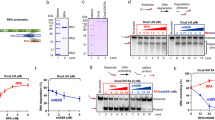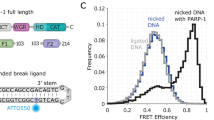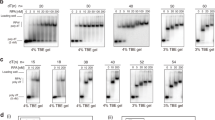Abstract
The human Rad50/Mre11/Nbs1 complex (hR/M/N) functions as an essential guardian of genome integrity by directing the proper processing of DNA ends, including DNA breaks1. This biological function results from its ability to tether broken DNA molecules2,3. hR/M/N's dynamic molecular architecture consists of a globular DNA-binding domain from which two 50-nm-long coiled coils protrude. The coiled coils are flexible4 and their apices can self-associate5. The flexibility of the coiled coils allows their apices to adopt an orientation favourable for interaction. However, this also allows interaction between the tips of two coiled coils within the same complex, which competes with and frustrates the intercomplex interaction required for DNA tethering. Here we show that the dynamic architecture of hR/M/N is markedly affected by DNA binding. DNA binding by the hR/M/N globular domain leads to parallel orientation of the coiled coils; this prevents intracomplex interactions and favours intercomplex associations needed for DNA tethering. The hR/M/N complex thus is an example of a biological nanomachine in which binding to its ligand, in this case DNA, affects the functional conformation of a domain located 50 nm distant.
This is a preview of subscription content, access via your institution
Access options
Subscribe to this journal
Receive 51 print issues and online access
$199.00 per year
only $3.90 per issue
Buy this article
- Purchase on Springer Link
- Instant access to full article PDF
Prices may be subject to local taxes which are calculated during checkout




Similar content being viewed by others
References
Connelly, J. C. & Leach, D. R. Tethering on the brink: the evolutionarily conserved Mre11–Rad50 complex. Trends Biochem. Sci. 27, 410–418 (2002)
de Jager, M. et al. Human Rad50/Mre11 is a flexible complex that can tether DNA ends. Mol. Cell 8, 1129–1135 (2001)
Wiltzius, J. J. W., Hohl, M., Fleming, J. C. & Petrini, J. H. J. The Rad50 hook domain is a critical determinant of Mre11 complex functions. Nature Struct. Mol. Biol. 12, 403–407 (2005)
van Noort, J. et al. The coiled-coil of the human Rad50 DNA repair protein contains specific segments of increased flexibility. Proc. Natl Acad. Sci. USA 100, 7581–7586 (2003)
Hopfner, K. P. et al. The Rad50 zinc-hook is a structure joining Mre11 complexes in DNA recombination and repair. Nature 418, 562–566 (2002)
Hopfner, K. P. et al. Structural biology of Rad50 ATPase: ATP-driven conformational control in DNA double-strand break repair and the ABC-ATPase superfamily. Cell 101, 789–800 (2000)
Hopfner, K. P. et al. Structural biochemistry and interaction architecture of the DNA double-strand break repair Mre11 nuclease and Rad50 ATPase. Cell 105, 473–485 (2001)
Wyman, C. & Kanaar, R. Chromosome organization: reaching out to embrace new models. Curr. Biol. 12, R446–R448 (2002)
de Jager, M. et al. Differential arrangements of conserved building blocks among homologs of the Rad50/Mre11 DNA repair protein complex. J. Mol. Biol. 339, 937–949 (2004)
de Jager, M. et al. DNA-binding and strand-annealing activities of human Mre11: implications for its roles in DNA double-strand break repair pathways. Nucleic Acids Res. 29, 1317–1325 (2001)
Stracker, T. H., Theunissen, J. W., Morales, M. & Petrini, J. H. J. The Mre11 complex and the metabolism of chromosome breaks: the importance of communicating and holding things together. DNA Repair (Amst.) 3, 845–854 (2004)
Acknowledgements
We thank T. Paull for the gift of the baculoviruses producing hRad50, hMre11 and hNbs1, and R. Seidel for useful discussions. F.M.-H. is supported by a postdoctoral fellowship from La Fundación Ramón Areces. M.d.J. is supported by an EUR fellowship from the Erasmus MC. This project is supported in part by a grant from NWO-FOM/ALW (Netherlands Organization for Scientific Research) to R.K., C.W. and C.D. Work in the laboratories of R.K. and C.W. is supported by grants from the European Commission, NWO and the Dutch Cancer Society. Work in the laboratory of C.D. and N.D. acknowledges support from FOM and NWO.
Author information
Authors and Affiliations
Corresponding authors
Ethics declarations
Competing interests
Reprints and permissions information is available at npg.nature.com/reprintsandpermissions. The authors declare no competing financial interests.
Supplementary information
Supplementary Figure S1
The hR/M complexes move along the DNA while following the contour of the DNA molecule. (PDF 103 kb)
Supplementary Movies Legends
Text descriptions to accompany the below Supplementary Movies. (DOC 19 kb)
Supplementary Movie S1
Atomic force microscopy movie of a free hR/M complex imaged in buffer. (AVI 4034 kb)
Supplementary Movie S2
Dynamic transition between the architecture of DNA-bound hR/M and DNA-free hR/M. (AVI 3842 kb)
Rights and permissions
About this article
Cite this article
Moreno-Herrero, F., de Jager, M., Dekker, N. et al. Mesoscale conformational changes in the DNA-repair complex Rad50/Mre11/Nbs1 upon binding DNA. Nature 437, 440–443 (2005). https://doi.org/10.1038/nature03927
Received:
Accepted:
Issue Date:
DOI: https://doi.org/10.1038/nature03927
This article is cited by
-
Chemo-mechanical forces modulate the topology dynamics of mesoscale DNA assemblies
Nature Communications (2023)
-
Rad50 zinc hook functions as a constitutive dimerization module interchangeable with SMC hinge
Nature Communications (2020)
-
The condensin holocomplex cycles dynamically between open and collapsed states
Nature Structural & Molecular Biology (2020)
-
Structural basis of homologous recombination
Cellular and Molecular Life Sciences (2020)
-
Eukaryotic Rad50 functions as a rod-shaped dimer
Nature Structural & Molecular Biology (2017)
Comments
By submitting a comment you agree to abide by our Terms and Community Guidelines. If you find something abusive or that does not comply with our terms or guidelines please flag it as inappropriate.



